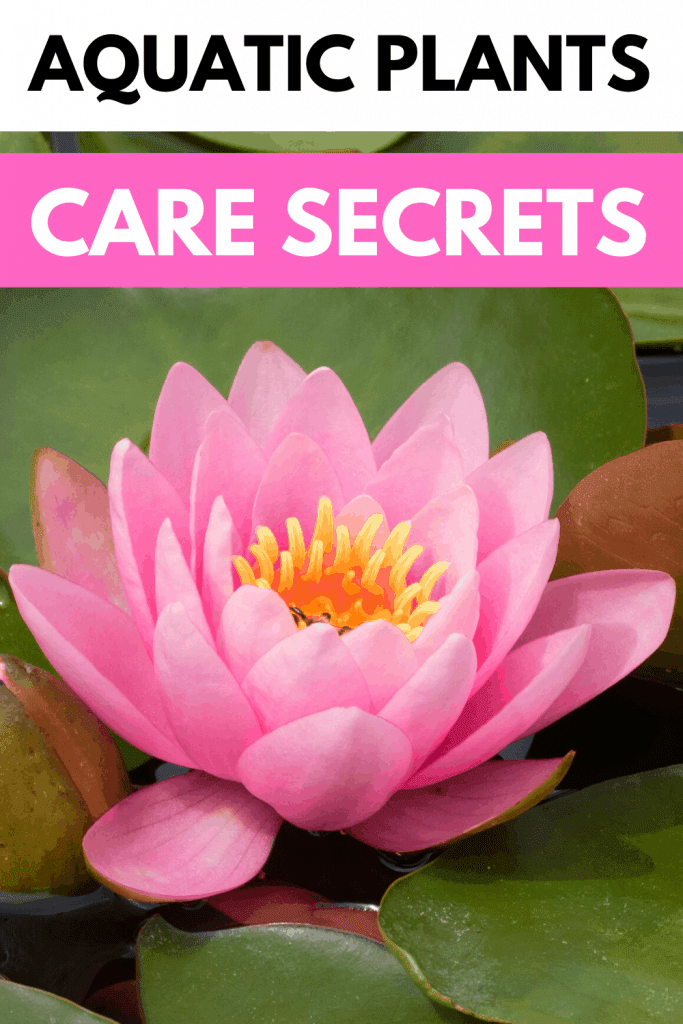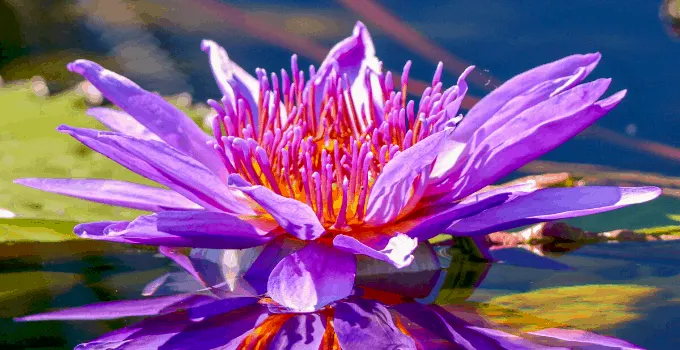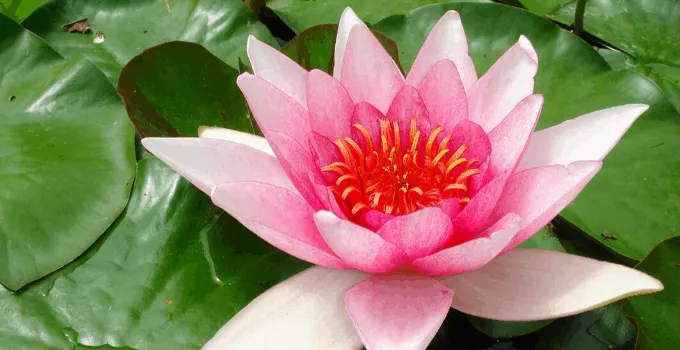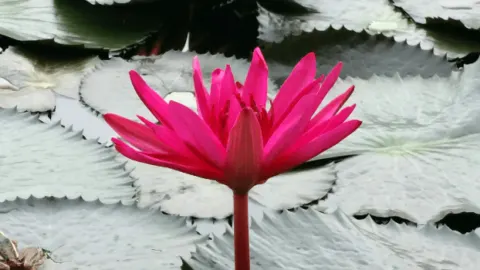Having a water-loving, or hydrophilic, plant is a worthy and fascinating addition to any home!
Aquatic plants, as one would guess, thrive in both saltwater and freshwater environments.
They are broken up into two separate groups. One of these categories involves plants that are partially or fully submerged, while the others sit on top of the water. Either way, these individuals always spark a discussion.
Aquatic plants are one of the earliest plants that existed. In fact, they’ve been dated back to the times of the Early Cretaceous, when dinosaurs might have roamed the Earth.
Given their atypical environment, you may be at a loss for how to take care of an aquatic plant. Do they need soil? Can you place them in a container with just any water?
In this article, we will answer all of your questions regarding the care of an aquatic plant, and explore the depths of these interesting floras!
Table of Contents

Aquatic Plants Basic Care Instructions
Being partially – or even completely – underwater, these plants have a number of needs despite not being your typical houseplant. Of course, one of those requirements is water. But, what about the rest? The top considerations are light, oxygen exchange, and nutrients. Read on to understand what else will make your aquatic plant happy.
SOIL
You may be surprised to find that even aquatic plants need to have soil. There are so many different options depending on the type of water plant that you have.
In general, aquatic plants tend to the happiest when placed in clay based potting mix. Clay holds onto nutrients more so than other types of soil. It’s also compact enough to hold the plant down despite the pressure of the water around it.
There are a few other options that work for plants that live in the water, but don’t the same benefits. These include sandy garden soil, potting soil, and cat litter.
Although fitting for pond or bog plants, they can work for aquatic plants as a whole. Anything higher in organic matter won’t be able to secure the plant to the bottom of the tank.
LIGHT
Light is one of the most important aspects when it comes to the overall care of an aquatic plant. They need quite a bit of light in order to gain enough energy to stay happy.
Without it, they can’t take in the carbon dioxide that is released into the water surrounding them. On the other end of the spectrum, too much light can also be hazardous. Growing underwater has its drawbacks.
With an over-abundance of light, algae will intercede, essentially suffocating the water and turning it green. Algae in general aren’t bad, just as long as it doesn’t overtake the entire tank.
The amount of light depends on what kind of light your plant receives. If you can manage to place your aquatic plant in a windowsill with full light, do so for only five hours.
Algae tend to grow more rapidly with direct light. We recommend finding a spot in your house that gets a maximum of 8 hours worth of natural light in a day.
WATERING
With “aquatic” in the name, it isn’t far of a jump to assume that these plants require special care in terms of their moisture content.
You might think it’s as simple as providing said water in the tank or container, but that’s only the bare minimum.
There are a number of other variables that one would take into consideration such as alkalinity of the water, how often the environment should be changed or filtered, and the temperature of the water.
The alkalinity of the wall should be anywhere between 3 and 8 dKH, or 54 to 140 ppm. Algae tend to form if nitrate levels pass 10 ppm and phosphate 0.5 ppm. The water itself should be filtered bi-weekly.
Don’t worry about the specifics for now. We will look at these details later on.
TEMPERATURE
Temperature also plays a somewhat vital role when it comes to the care of your aquatic plants. These individuals like to have warmer environments so that the plants are allowed to flourish.
Cranking up the heat too high can have negative impacts. Algal blooms are known for growing rapidly when placed in higher temperatures.
Your aquatic plants will likely yield the best results when their container or tank sits between 23 and 26 degrees Celsius or 74 to 80 degrees Fahrenheit.
Another important aspect to keep in mind is that the temperature may vary within your tank, but it should never drastically change. You can avoid this by not placing your plant near a window.
HUMIDITY
Most of the plants that we talk about on this website don’t require high levels of humidity. Sure, some will do best when given a good mist here and there, but it doesn’t come close to what aquatic plants need.
Regardless of if you keep your flora in a tank, dome, or other sort of container, you’ll want the humidity to be around 75 or 85 percent.
This can differ depending on the species, so make sure to do your research.
One of the easiest ways to accomplish this is to make sure that the temperature remains somewhat warm.
The water will evaporate with the added heat, thus increasing the overall humidity in the process.
FERTILIZER
You may think to yourself that plants kept in tanks don’t really need fertilizer.
We’ve found this to be false. Aquatic plants tend to need the extra help because of the fact that they are surrounded by water, and they don’t get as much sunlight as terrestrial individuals.
Since water dilutes nutrients, you’ll want to add fertilizer. You can do this through the use of liquid fertilizer, or capsules that you’d put into the substrate.
Aquatic plants can absorb nutrients through their leaves and roots despite being surrounded by water. We suggest doing this every week. This in combination with changing your water will be enough to help your plants thrive.
PROPAGATION
Propagating plants is a great way to create copies of the parent individual. It also is a great way to ensure that the plant stays healthy! The most common method of propagation for aquatic plants is through stem cuttings.
This involves taking sections from the parent flora and planting it in a different spot so that it can grow roots of its own. Another option is through what is referred to as “sexual propagation”, where growth arises from seeds.
This way can be slightly more tedious.
Stem cuttings are preferable among most aquatic plant owners due to how easy the overall process is, and how quick new growth takes form.
We will discuss the steps involved in this propagation technique later on!
GROWTH
One fun aspect about aquatic plants is how they vary in overall size. You can find a species to fit the needs of your house.
The Water Wisteria, for instance, grows to be around 20 inches in height with a width of 10 inches, making them a fun tank individual.
Marimo Moss Balls only reach a total mass of 5 inches when placed into aquariums.
With such a wide variety, the amount of time that they take to grow depends on the species as well. Some of these individuals die annually, while others can last between five and 20 years.
Keeping all of their basic needs into consideration will ensure that your beloved underwater plant lasts a good amount of time!
POTTING
When we say, “potting”, it might not refer to the traditional sense. Aquatic plants are widely used as additions to a tank, making it difficult to repot.
This process, altogether, may be a bit more complicated than with your average houseplant. Repotting should happen in the early spring to avoid shock. If your plant lives in a pond, take the submerged pot from the area and switch out the soil.
You’ll want to add rocks around the top to anchor the lower half of the flora. Plants that live in a tank will need to be transferred with a complete water change. Do this carefully so that the individual is not damaged in the process.
Repotting really varies depending on the species and environment. Tank plants should be repotted every time you need to change the water, while potted, submerged individuals require this to take place at least once a year.

Close-up of the beautiful Egyptian Lotus Aquatic plant. There are many different types of aquatic plants. The classification of these plants is problematic in itself. A common classification divides aquatic plants in four categories: Algae, Floating plants, Submerged plants (totally in water) & Emergent plants.
AQUATIC PLANTS AND THE NECESSITY OF WATER
Being one of the core aspects to consider when bringing home an aquatic plant, we’ve given this basic need its own section. As mentioned earlier, there are a number of components that people don’t think about in terms of watering.
Water quality, salinity, nutrients, and filtration are the key essentials. We recommend using deionized water with some form of solution meant to help with pH levels, such as a Freshwater Renewal product for your tank.
Tap water isn’t the worst option, though this can depend on where you live. The correct salinity will change based on where your plant resides. Freshwater tanks, for instance, require lower levels.
Other elements that need to be taken into account are the nutrients and filtration system. Aquatic plants are great for helping to maintain a healthy ecosystem for your tanked critters.
In general, they are known for taking in Carbon Dioxide and adding filtered oxygen to your home. In order to do this, they need to have the correct nutrients.
Keeping nitrate and phosphate levels at a lower percentage is best! Changing out the water on a somewhat regular basis can also help with this.
The overall rule is to change about 10 percent of the water every week, or 25 percent every two weeks. This will remove any pollutants and decrease the growth of algae.
PROPAGATING YOUR AQUATIC PLANT
There are two methods of propagation involved with aquatic plants, one of which is more hands on.
You can opt to grow your flora from a seed, but this is more troublesome, especially with them being submerged in the water.
Propagating your aquatic plant through stem cuttings is a more widely accepted method.
Not every species of aquatic plant can be divided through this method, so keep in mind that it works for lengthier individuals! Here are the steps involved!
PROPAGATION THROUGH STEM CUTTINGS
- Decide to propagate your plant during the right time of the year, preferably during the early spring when your aquatic flora hasn’t yet undergone new growth.
- Use a clean pair of scissors and make a cut along the stem that is at least three inches in length. You don’t need to remove the plant from the water to make these cuts.
- There will be a number of leaves growing along your stem cuttings. Take off any foliage that is located on the last third portion of the plant.
- Take your newly cut stem and place it down into the environment that you wish to grow them in, inserting the open end of the stem into the gravel so that it doesn’t become dislodged.
- You’ll notice that the parent plant regrows those sections that were cut, making them become denser within a week.
- Your new stems will start to develop roots within a week, with the entire root system taking shape in two or three weeks.
PESTS AND AQUATIC PLANTS
Just because these types of plants are at least rooted in water does not make them fall prey to various insects or diseases.
Being aware of these potential invaders will help your plant later down the road.
The key to helping an infected plant is to identify the problem early on. Thus, knowing the signs and likely bugs is essential!
We have an article on aphid removal for those who want more info on the matter!
The most common pests that will attack a water plant include aphids, leaf beetles, leaf-mining midges, and the China mark moth.
These insects are more likely to go after pond plants rather than an individual that’s kept in a tank.
Dealing with a pest in the water needs to be done carefully so that the overall pH level and salinity is not disrupted. You can find water-safe methods to control bug infestations.
Diseases are much less typical when it comes to aquatic plants.
They can also be solved rather easily with the addition of fertilizers and a complete water change.
One disease that you’ll want to keep an eye out for is Crypt rot.
This happens when the plant’s conditions are suddenly changed, thus weakening the flora’s overall ability to thrive.
The good thing about Crypt rot is that it is easy to turn around just as long as the roots are relatively healthy.

Close-up of a beautiful Nymphaea flower.
AQUATIC PLANT PROBLEMS
Diseases and bugs aren’t the only thing that you need to watch out for. There are a number of problems that may arise along the way. We’ve pinpointed the four most common so that you can stay ahead of the curve!
PROBLEM #1: BLACK ALGAE
Algae are relatively common when it comes to a tank environment. Dark growth along the plant itself is concerning, and is usually a result of too much phosphate.
Defeating black algae all depends on how well you care for your aquatic plant. Replace any old filters and try to increase the overall lighting.
PROBLEM #2: YELLOW LEAVES
The typical color of an aquatic plant ranges in various colors of green.
The yellowing of foliage signals that your tank isn’t getting enough light and needs help.
There are a few ways in which you can increase the lighting conditions for your aquatic plant. Artificial lighting is the easiest, but you can also opt for a window location.
PROBLEM #3: HOLE FILLED FOLIAGE
Although appearing small at first, holes in the leaves can eventually lead to complete fragmentation. Remember how we had discussed Crypt rot before? This is a sign of that disease. Any drastic change can lead to this problem.
Your plant will begin to repair itself if it’s early enough. All you need to do is change the water and increase the quality of the environment. Over the next few weeks, try to keep all of the conditions stabilized!
PROBLEM #4: ROTTING LEAVES
The yellowing of leaves alludes to a depletion of light, while a full-on brown, rotting hue hints at an iron deficiency.
There are fertilizers specifically designed to add more iron to your tank to improve the overall well-being of your aquatic plant.
5 TAKEAWAYS TO A THRIVING AQUATIC PLANT
Living under the sea – well, under the water at least – can be challenging for a plant. Knowing the proper steps in terms of overall care is key!
- Choose soil that is clay-based, and secure your plant with gravel!
- Make sure that it gets plenty of light, whether that is artificial or natural.
- Add fertilizer on a weekly basis to help with the growth of your plant.
- Focus on making sure that the conditions surrounding your aquatic plant do not change drastically to avoid any shock or disease.
- Keep the humidity anywhere between 75 to 85 degrees!
AQUATIC PLANT FAQ
What are the three types of aquatic plants?
You can either have an aquatic plant that floats on the surface, is partially submerged, or fully within the water.
Can aquatic plants live in tap water?
Tap water is more than acceptable unless it is higher in chlorine. If that’s the case, treat your water.
How do aquatic plants help fish?
Aquatic plants provide oxygen, and work well to absorb carbon dioxide produced by the fish. Overall, they are a wise choice for tank occupants.

Daniel has been a plant enthusiast for over 20 years. He owns hundreds of houseplants and prepares for the chili growing seasons yearly with great anticipation. His favorite plants are plant species in the Araceae family, such as Monstera, Philodendron, and Anthurium. He also loves gardening and is growing hot peppers, tomatoes, and many more vegetables.


